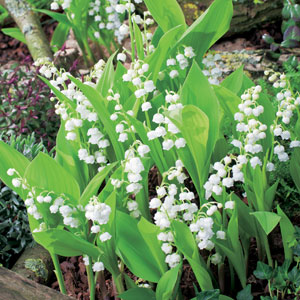Lily of the Valley Growing Guide

What is Lily of the Valley?
Lily of the Valley (Convallaria majalis) is a herbaceous perennial. It is part of the Liliaceae family and is native to Europe. The rhizome forms upright clumping foliage that is flat and board. During the flowering period in Spring slightly arching flower stems will appear and all along the stem will be dainty bell shaped flower heads. The flowers can either be coloured white or pink and have a beautiful perfume. Lily of the Valley prefers a shaded position in the garden that is cold and damp with plenty of compost and leaf mulch. They take a few years to become established and are best when undisturbed.
Benefits of Growing Lily of the Valley
Lily of the Valley makes a stunning cut flower. It is highly sort after for a brides bouquet, with their dainty fragrant flowers. It symbolises sweetness and purity of heart. Lily of the Valley are very popular to be used as a ground cover in shady areas and woodland settings. They make a fantastic plant for planting beneath the canopy of a large tree. They are also suited to grow in pots for those who wish to grow them in courtyards, on verandahs or to bring them inside during flowering time.
How to Grow Lily of the Valley
Climatic Zones
Cool to temperate.
Plant Size
Height: 45cm, Width: 30cm
When To Plant Lily of the Valley
Plant in Winter.
Soil Preparation
They prefer well drained, moist humus rich soil. Dig through well broken down animal manure, blood and bone or a complete fertiliser before planting.
How To Plant Lily of the Valley
Plant in semi shade to full shade, 10cm apart with the rhizome 3cm below the soil surface.
Lily of the Valley Plant Care
Needs to be kept moist during Spring and Summer so water when rainfall is not sufficient.
A top dressing of well broken down animal manure in Winter will also assist growth and produce larger blooms. They also likes to be mulched regularly with a leafy moss or compost.
They like to be left undisturbed once established. After a while the clumps may get to a size that needs separating and should be done when the plant is dormant in Winter.
Watch out for aphids as the weather warms up. Check for snails and slugs around the foliage.







